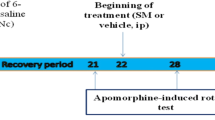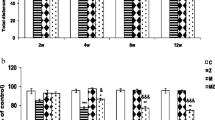Abstract
Oxidative stress is closely involved in neurodegenerative diseases. The present study aimed to examine the effect of anti-oxidant DHM (dihydromyricetin) on 3NP (3-nitropropionic acid) -induced behavioral deficits of experimental rats and striatal histopathological injury by using behavioral, imaging, biochemistry, histochemistry and molecular biology technologies. The experimental results showed that both motor dysfunctions and learning and memory impairments induced by 3NP were significantly reduced after DHM treatment. 3NP-induced striatal metabolic abnormality was also remarkably improved by DHM treatment, showed as the increased glucose metabolism in PET/CT scan, decreased MDA (malondialdehyde) and increased SOD (superoxide dismutase) activity in enzyme histochemical staining. In addition, the cell apoptosis was evidently detected in the striatum of the 3NP group, while in the 3NP + DHM group, the number of apoptotic cells was remarkably reduced. 3NP treatment obviously induced down-regulation of Bcl-2, and up-regulations of Bax and Cleaved Caspase-3, while these changes were significantly reversed by DHM treatment. The present results suggested that DHM showed its protective effect by anti-oxidant and anti-apoptosis mechanisms.




Similar content being viewed by others
References
Acuna AI, Esparza M, Kramm C, Beltran FA, Parra AV, Cepeda C, Toro CA, Vidal RL, Hetz C, Concha II, Brauchi S, Levine MS, Castro MA (2013) A failure in energy metabolism and antioxidant uptake precede symptoms of Huntington’s disease in mice. Nat Commun 4:2917
Binawade Y, Jagtap A (2013) Neuroprotective effect of lutein against 3-nitropropionic acid-induced Huntington’s disease-like symptoms: possible behavioral, biochemical, and cellular alterations. J Med Food 16(10):934–43
Binienda Z, Simmons C, Hussain S, Slikker W Jr, Ali SF (1998) Effect of acute exposure to 3-nitropropionic acid on activities of endogenous antioxidants in the rat brain. Neurosci Lett 251(3):173–6
Browne SE, Bowling AC, MacGarvey U, Baik MJ, Berger SC, Muqit MM, Bird ED, Beal MF (1997) Oxidative damage and metabolic dysfunction in Huntington’s disease: selective vulnerability of the basal ganglia. Ann Neurol 41(5):646–53
Choi YJ, Om JY, Kim NH, Chang JE, Park JH, Kim JY, Lee HJ, Kim SS, Chun W (2013) Heat shock transcription factor-1 suppresses apoptotic cell death and ROS generation in 3-nitropropionic acid-stimulated striatal cells. Mol Cell Biochem 375(1-2):59–67
de Oliveira MR, Nabavi SF, Habtemariam S, Erdogan Orhan I, Daglia M, Nabavi SM (2015) The effects of baicalein and baicalin on mitochondrial function and dynamics: a review. Pharmacol Res 100:296–308
Eno CO, Zhao G, Olberding KE, Li C (2012) The Bcl-2 proteins Noxa and Bcl-xL co-ordinately regulate oxidative stress-induced apoptosis. Biochem J 444(1):69–78
Feng Q, Ma Y, Mu S, Wu J, Chen S, Ouyang L, Lei W (2014) Specific reactions of different striatal neuron types in morphology induced by quinolinic acid in rats. PLOS ONE 9(3):e91512:1–11
Figueredo-Cardenas G, Chen Q, Reiner A (1997) Age-dependent differences in survival of striatal somatostatin-NPY-NADPH-diaphorase-containing interneurons versus striatal projection neurons after intrastriatal injection of quinolinic acid in rats. Exp Neurol 146:444–457
Gopinath K, Sudhandiran G (2012) Naringin modulates oxidative stress and inflammation in 3-nitropropionic acid-induced neurodegeneration through the activation of nuclear factor-erythroid 2-related factor-2 signalling pathway. Neuroscience 227:134–43
Gu M, Gash MT, Mann VM, Javoy-Agid F, Cooper JM, Schapira AH (1996) Mitochondrial defect in Huntington’s disease caudate nucleus. Ann Neurol 39(3):385–9
Huang Q, Zhou D, Sapp E, Aizawa H, Ge P, Bird ED, Vonsattel JP, DiFiglia M (1995) Quinolinic acid induced increases in calbindin D28k immunoreactivity in rat striatal neurons in vivo and in vitro mimic the pattern seen in Huntington’s disease. Neuroscience 65:397–407
Jiang B, Le L, Pan H, Hu K, Xu L, Xiao P (2014) Dihydromyricetin ameliorates the oxidative stress response induced by methylglyoxal via the AMPK/GLUT4 signaling pathway in PC12 cells. Brain Res Bull 109:117–26
Kumar P, Kumar A (2009) Possible neuroprotective effect of Withania somnifera root extract against 3-nitropropionic acid-induced behavioral, biochemical, and mitochondrial dysfunction in an animal model of Huntington’s disease. J Med Food 12(3):591–600
Kumar P, Kumar A (2010) Protective effect of hesperidin and naringin against 3-nitropropionic acid induced Huntington’s like symptoms in rats: possible role of nitric oxide. Behav Brain Res 206(1):38–46
Kumar P, Kalonia H, Kumar A (2010a) Possible nitric oxide modulation in protective effect of FK-506 against 3-nitropropionic acid-induced behavioral, oxidative, neurochemical, and mitochondrial alterations in rat brain. Drug Chem Toxicol 33(4):377–92
Kumar P, Kalonia H, Kumar A (2010b) Protective effect of sesamol against 3-nitropropionic acid-induced cognitive dysfunction and altered glutathione redox balance in rats. Basic Clin Pharmacol Toxicol 107(1):577–82
Liang J, López-Valdés HE, Martínez-Coria H, Lindemeyer AK, Shen Y, Shao XM, Olsen RW (2014) Dihydromyricetin ameliorates behavioral deficits and reverses neuropathology of transgenic mouse models of Alzheimer’s disease. Neurochem Res 39(6):1171–81
Ma Y, Feng Q, Ma J, Feng Z, Zhan M, Ouyang L, Mu S, Liu B, Jiang Z, Jia Y, Li Y, Lei W (2013) Melatonin ameliorates injury and specific responses of ischemic striatal neurons in rats. J Histochem Cytochem 61(8):591–605
Ma Y, Zhan M, OuYang L, Li Y, Chen S, Wu J, Chen J, Luo C, Lei W (2014) The effects of unilateral 6-OHDA lesion in medial forebrain bundle on the motor, cognitive dysfunctions and vulnerability of different striatal interneuron types in rats. Behav Brain Res 266:37–45
Mehrotra A, Kanwal A, Banerjee SK, Sandhir R (2015) Mitochondrial modulators in experimental Huntington’s disease: reversal of mitochondrial dysfunctions and cognitive deficits. Neurobiol Aging 36(6):2186–200
Mu S, OuYang L, Liu B, Zhu Y, Li K, Zhan M, Liu Z, Jia Y, Lei W, Reiner A (2011a) Preferential interneuron survival in the transition zone of 3-NP-induced striatal injury in rats. J Neurosci Res 89:744–754
Mu S, OuYang L, Liu B, Zhu Y, Li K, Zhan M, Liu Z, Jia Y, Lei W (2011b) Protective effect of melatonin on 3-NP induced striatal interneuron injury in rats. Neurochem Int 59(2):224–34
Mu S, Lin E, Liu B, Ma Y, OuYang L, Li Y, Chen S, Zhang J, Lei W (2014) Melatonin reduces projection neuronal injury induced by 3-nitropropionic acid in the rat striatum. Neurodegener Dis 14(3):139–50
Nasr P, Gursahani HI, Pang Z, Bondada V, Lee J, Hadley RW, Geddes JW (2003) Influence of cytosolic and mitochondrial Ca2+, ATP, mitochondrial membrane potential, and calpain activity on the mechanism of neuron death induced by 3-nitropropionic acid. Neurochem Int 43(2):89–99
Nijhawan D, Honarpour N, Wang X (2000) Apoptosis in neural development and disease. Annu Rev Neurosci 23:73–87
Packard MG, Knowlton BJ (2002) Learning and memory functions of the Basal Ganglia. Annu Rev Neurosci 25:563
Palfi S, Ferrante RJ, Brouillet E, Beal MF, Dolan R, Guyot MC, Peschanski M, Hantraye P (1996) Chronic 3-nitropropionic acid treatment in baboons replicates the cognitive and motor deficits of Huntington’s disease. J Neurosci 16(9):3019–25
Rajendran P, Rengarajan T, Nandakumar N, Palaniswami R, Nishigaki Y, Nishigaki I (2014) Kaempferol, a potential cytostatic and cure for inflammatory disorders. Eur J Med Chem 86:103–12
Rosenstock TR, Carvalho AC, Jurkiewicz A, Frussa-Filho R, Smaili SS (2004) Mitochondrial calcium, oxidative stress and apoptosis in a neurodegenerative disease model induced by 3-nitropropionic acid. J Neurochem 88(5):1220–8
Sandhir R, Mehrotra A (2013) Quercetin supplementation is effective in improving mitochondrial dysfunctions induced by 3-nitropropionic acid: implications in Huntington’s disease. Biochim Biophys Acta 1832(3):421–30
Sassone J, Maraschi A, Sassone F, Silani V, Ciammola A (2013) Defining the role of the Bcl-2 family proteins in Huntington’s disease. Cell Death Dis 4:e772
Shear DA, Dong J, Gundy CD, Haik-Creguer KL, Dunbar GL (1998) Comparison of intrastriatal injections of quinolinic acid and 3-nitropropionic acid for use in animal models of Huntington’s disease. Prog Neuropsychopharmacol Biol Psychiatry 22:1217
Shear DA, Haik KL, Dunbar GL (2000) Creatine reduces 3-nitropropionic-acid-induced cognitive and motor abnormalities in rats. Neuroreport 11(9):1833–7
Shen Y, Lindemeyer AK, Gonzalez C, Shao XM, Spigelman I, Olsen RW, Liang J (2012) Dihydromyricetin as a novel anti-alcohol intoxication medication. J Neurosci 32(1):390–401
Srinivasan A, Thangavel C, Liu Y, Shoyele S, Den RB, Selvakumar P, Lakshmikuttyamma A (2015) Quercetin regulates β-catenin signaling and reduces the migration of triple negative breast cancer. Mol Carcinog 55(5):743–56
Sun Z, Xie J, Reiner A (2002) The differential vulnerability of striatal projection neurons in 3-nitropropionic acid-treated rats does not match that typical of adult-onset Huntington’s disease. Exp Neurol 176(1):55–65
Tabrizi SJ, Cleeter MW, Xuereb J, Taanman JW, Cooper JM, Schapira AH (1999) Biochemical abnormalities and excitotoxicity in Huntington’s disease brain. Ann Neurol 45(1):25–32
Tasset I, Agüera E, Olmo-Camacho R, Escribano B, Sánchez-López F, Delgado MJ, Cruz AH, Gascón F, Luque E, Peña J, Jimena IM, Túnez I (2011) Melatonin improves 3-nitropropionic acid induced behavioral alterations and neurotrophic factors levels. Prog Neuropsychopharmacol Biol Psychiatry 35(8):1944–9
Tsang TM, Haselden JN, Holmes E (2009) Metabonomic characterization of the 3-nitropropionic acid rat model of Huntington’s disease. Neurochem Res 34(7):1261–71
Xie J, Liu J, Chen TM, Lan Q, Zhang QY, Liu B, Dai D, Zhang WD, Hu LP, Zhu RZ (2015) Dihydromyricetin alleviates carbon tetrachloride-induced acute liver injury via JNK-dependent mechanism in mice. World J Gastroenterol 21(18):5473–81
Yang J, Liu X, Bhalla K, Kim CN, Ibrado AM, Cai J, Peng TI, Jones DP, Wang X (1997) Prevention of apoptosis by Bcl-2: release of cytochrome c from mitochondria blocked. Science 275(5303):1129–32
Youle RJ, Strasser A (2008) The BCL-2 protein family: opposing activities that mediate cell death. Nat Rev Mol Cell Biol 9(1):47–59
Zhao K, Zhao GM, Wu D, Soong Y, Birk AV, Schiller PW, Szeto HH (2004) Cell-permeable peptide antioxidants targeted to inner mitochondrial membrane inhibit mitochondrial swelling, oxidative cell death, and reperfusion injury. J Biol Chem 279(33):34682–90
Acknowledgments
This research was supported by the National Science Foundation of China (No. 81471288, 31070941 and 81301063), by the Major State Basic Research Development Program of China (973 Program, No. 2010CB530004) and by the Project 2016075 supported by SZU R/D Fund.
Author information
Authors and Affiliations
Corresponding author
Ethics declarations
Conflict of Interest
The authors declare that they have no competing interests.
Additional information
Shuhua Mu and Youlan Li contributed equally to this work.
Rights and permissions
About this article
Cite this article
Mu, S., Li, Y., Liu, B. et al. Dihydromyricetin Ameliorates 3NP-induced Behavioral Deficits and Striatal Injury in Rats. J Mol Neurosci 60, 267–275 (2016). https://doi.org/10.1007/s12031-016-0801-0
Received:
Accepted:
Published:
Issue Date:
DOI: https://doi.org/10.1007/s12031-016-0801-0




